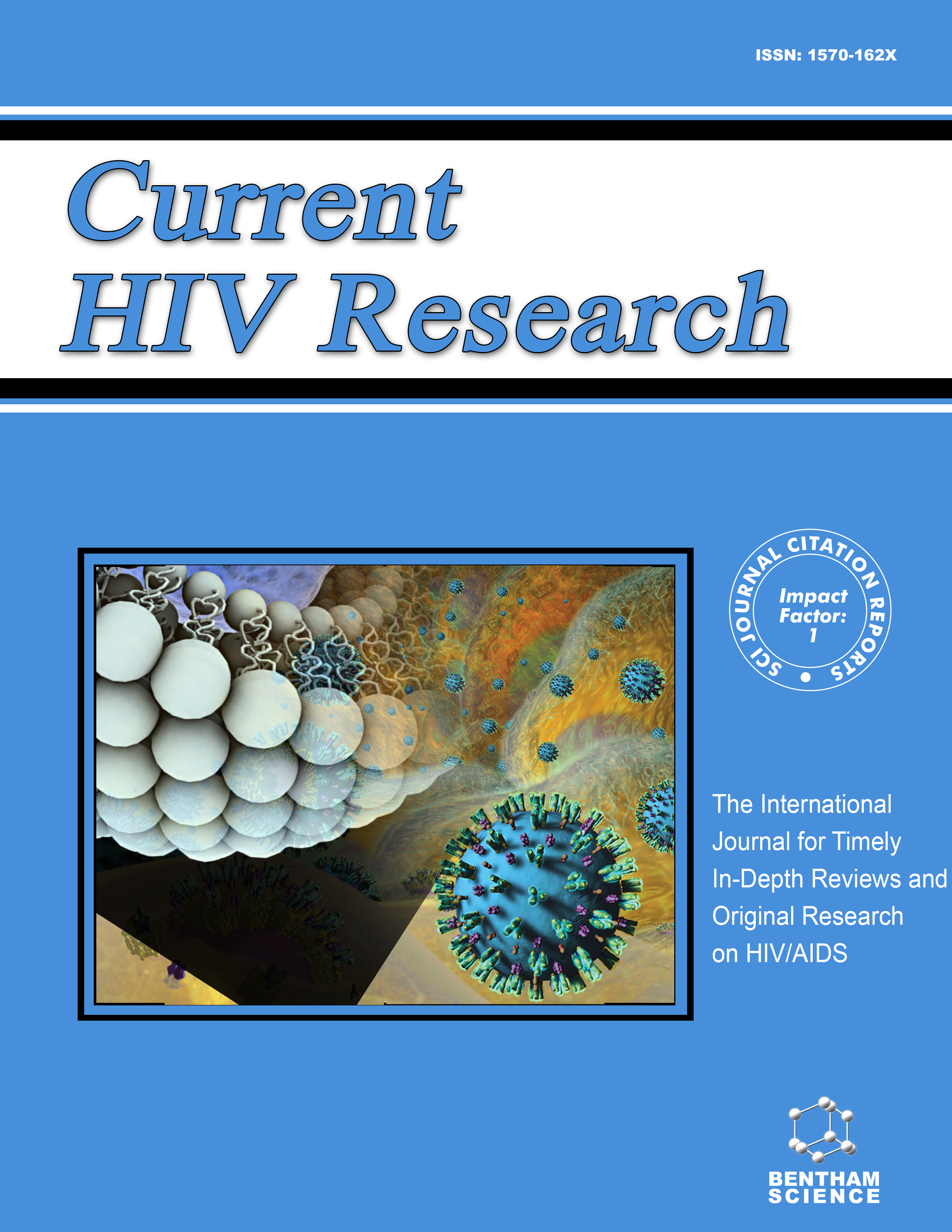- Home
- A-Z Publications
- Current HIV Research
- Previous Issues
- Volume 14, Issue 4, 2016
Current HIV Research - Volume 14, Issue 4, 2016
Volume 14, Issue 4, 2016
-
-
Formulation Development, Physicochemical Characterization and In Vitro-In Vivo Drug Release of Vaginal Films
More LessAuthors: Kajal Ghosal, Bipad Taran Hazra, Benoy Brata Bhowmik and Sabu ThomasPurpose: The purpose of this study was formulation and optimization of vaginal film formulation containing abacavir (ABC), a potent nucleoside reverse transcriptase inhibitor. Methods: Vaginal films were prepared by solvent evaporation method using hydroxypropyl methylcellulose (HPMC) blended with polyvinyl pyrrolidone (PVP). Various physicochemical parameters of the prepared films such as drug content, thickness, ten Read More
-
-
-
Current Approaches in Computational Drug Resistance Prediction in HIV
More LessAuthors: Mona Riemenschneider and Dominik HeiderBackground: Today a broad range of antiretroviral drug regimens are applicable for the successful suppression of virus replication in human immunodeficiency virus (HIV) infected people. However, there still remains an obstacle in therapy: the high mutation rate of the HI virus under drug pressure leads to resistant variants causing failure of permanent and effective treatment. Therefore, resistance testing is therefore inev Read More
-
-
-
Persistent But Not Replicating HIV-1 Cell-Associated DNA in Semen of Long-Term ART Experienced Men
More LessBackground: The semen of HIV-1 infected men represents the main vector of HIV-1 spread following sexual transmission of cell-free or cell-associated virions. Objective: The present study aimed to assess the impact of HAART on HIV-1 RNA/DNA and on inflammatory environment in the semen of long-term HAART-experienced men. Methods: Forty-five paired samples of semen and blood were obtained from 37 consentin Read More
-
-
-
Lower CSF Aβ is Associated with HAND in HIV-Infected Adults with a Family History of Dementia
More LessBackground: Both family history of dementia (FHD) and lower levels of Aβ-42 are indepentently associated with worse neurocognitive functioning in HIVinfected patients. Objective: To examine the relationships between cerebrospinal fluid (CSF) Aβ-42 and FHD with HIV-associated neurocognitive disorders (HAND). Methods: One hundred eighty-three HIV+ adults underwent neuropsychological and neuromedical assessments, and Read More
-
-
-
Blood Myeloid Dendritic Cells and slanDC in Antiretroviral Therapy- Suppressed HIV-Infected Patients
More LessMyeloid dendritic cells (mDCs) play a complex role in HIV infection regardless of viral replication. The aim of our study was to analyse mDCs in long term antiretroviral therapy (ART)- suppressed HIV-infected patients. We evaluated the numbers of mDCs and slanDC in the context of different degree of CD4+ T cell recovery, persistent T cell activation (as HLA-DR+/CD38+ expression) and monocyte-macrophage activation asse Read More
-
-
-
Chemokines SNPs in HIV-1+ Patients and Healthy Controls from Northeast Brazil: Association with Protection against HIV-1 Infection
More LessBackground: HIV-1 virus is known to infect the host mainly through CD4+ T-lymphocyte cells, by interactions among the viral envelope proteins, CD4 receptor and HIV-1 coreceptors, such as chemokines receptors. Variations in the genes encoding HIV-1 coreceptors and their natural ligands have been shown to modify HIV-1 infection susceptibility and disease progression. Methods and Results: We analysed the distribution of Read More
-
-
-
Disease Progression in HIV Late Presenters: the Role of HIV Clinical Indicator Diseases Prior to HIV Diagnosis
More LessAuthors: Viola Guardigni, Mario Luca Morieri, Daniela Segala and Laura SighinolfiBackground: Late diagnosis represents a major challenge in the control of HIV epidemics. The rate of disease progression is higher among late presenters. In Europe, HIV Clinical Indicator Diseases (CIDs) have been proposed to improve early diagnosis. Objectives: Our observational study evaluated the presence of these HIV CIDs prior to HIV diagnosis among a population of late presenters and assessed its correlation to di Read More
-
-
-
Assessment of the Accuracy of Whole Blood/Serum Rapid Point-of-Care HIV Three Dot Test for Oral Fluid Specimens
More LessAuthors: N. Rakesh, Shakilla Shetty, S. Sujatha, Shivani Sharma and Ankit SaxenaBackground: Saliva rapid point of care HIV tests have proven advantages over blood-based HIV tests in terms of quality, rapidity and convenience. Aim: To assess the sensitivity, specificity and reproducibility of saliva samples using the serum/ whole blood rapid test and to compare it with serum specimens. Material & Methods: 52 seropositive and 52 seronegative patients were included in the study. Stimulated and unstimulated s Read More
-
-
-
Prevalence of Drug Resistance Associated Mutations Among the Anti Retroviral Therapy Exposed HIV-1 Infected Individuals in Manipur, Northeast India
More LessBackground: Manipur is one of the highest HIV prevalence states of India because of its geographical location at the international border near the golden triangle of South-East Asia, but no study on drug resistance associated mutations (DRAMs) has been reported yet. Objective: A population-based study on DRAMs of HIV-1 among the anti-retroviral therapy (ART) exposed HIV-1 infected individuals of Manipur was conducted. M Read More
-
Volumes & issues
-
Volume 23 (2025)
-
Volume 22 (2024)
-
Volume 21 (2023)
-
Volume 20 (2022)
-
Volume 19 (2021)
-
Volume 18 (2020)
-
Volume 17 (2019)
-
Volume 16 (2018)
-
Volume 15 (2017)
-
Volume 14 (2016)
-
Volume 13 (2015)
-
Volume 12 (2014)
-
Volume 11 (2013)
-
Volume 10 (2012)
-
Volume 9 (2011)
-
Volume 8 (2010)
-
Volume 7 (2009)
-
Volume 6 (2008)
-
Volume 5 (2007)
-
Volume 4 (2006)
-
Volume 3 (2005)
-
Volume 2 (2004)
-
Volume 1 (2003)
Most Read This Month
Article
content/journals/chr
Journal
10
5
false
en


